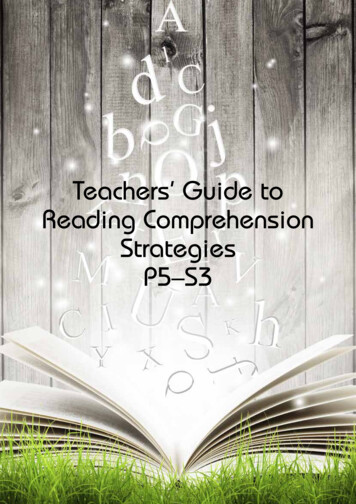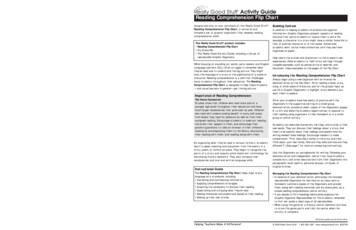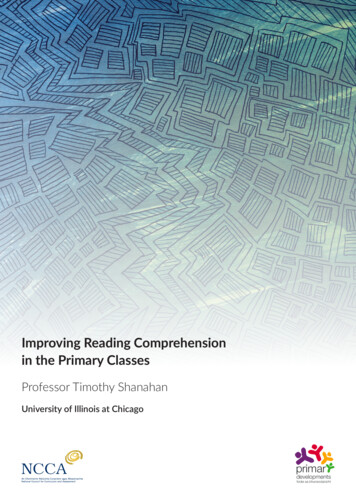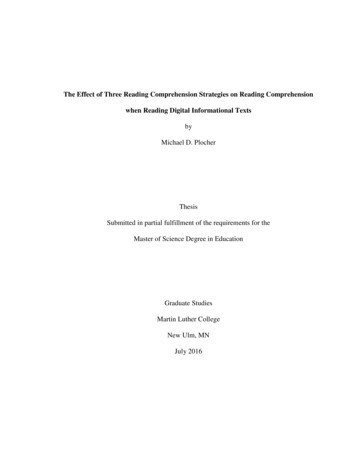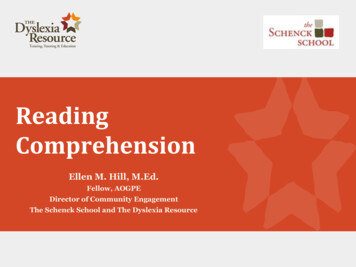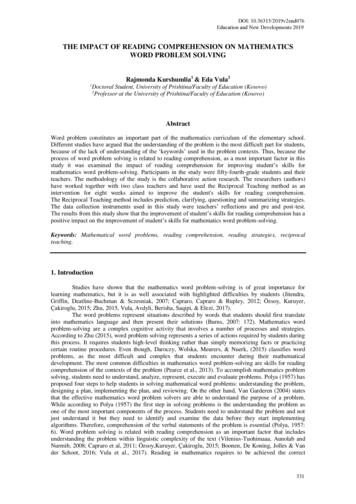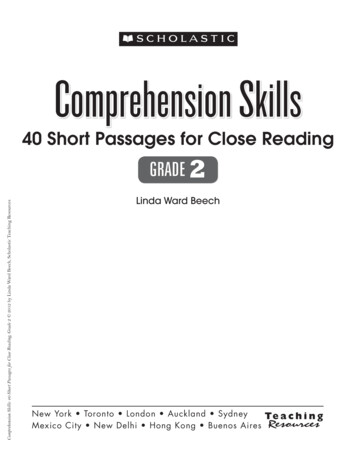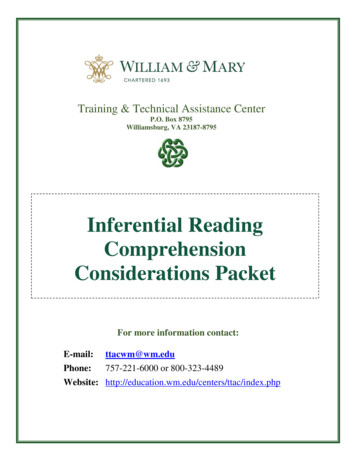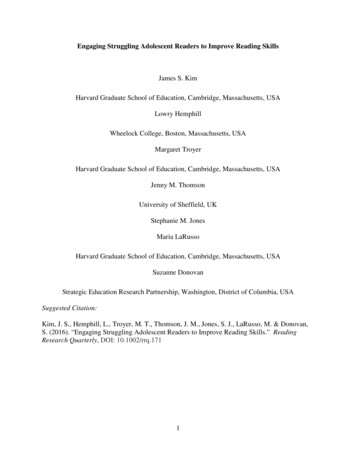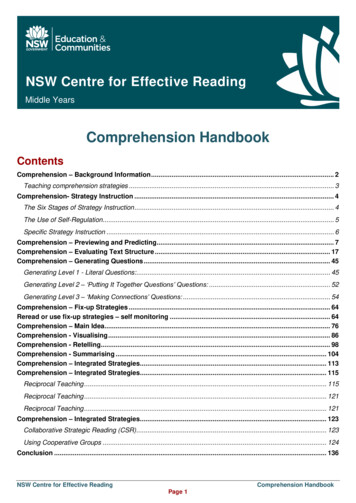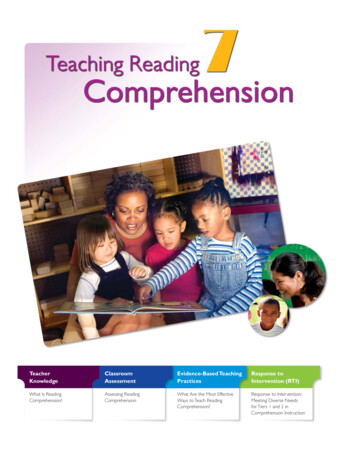
Transcription
Chapter 7 Teaching Reading idence-Based TeachingPracticesResponse toIntervention (RTI)What Is ReadingComprehension?Assessing ReadingComprehensionWhat Are the Most EffectiveWays to Teach ReadingComprehension?Response to Intervention:Meeting Diverse Needsfor Tiers 1 and 2 inComprehension Instruction
What is reading comprehension, and what does research say aboutreading comprehension instruction?How is reading comprehension assessed effectively?What are evidence-based instructional practices or strategies fordeveloping reading comprehension?Schema theoryHow can Tier 1 and Tier 2 comprehension instruction be adaptedto meet the needs of diverse learners including English learners(ELs)?Multiple comprehension strategiesHow can literature circles play a role in improving motivation tolearn comprehension skills?Construction-integration theoryBenchmark standardsMetacognitionStory grammarUnaided recallContent approachesHow are some ways that the Internet can be used to supportcomprehension instruction?VisualizingHow can families and communities support children’s readingcomprehension development?ScaffoldingText featuresInputTeaching modelingGuided practiceHigher-order thinkingQuestion–Answer Relationships (QARs)Questioning the authorElaborative interrogationFix-up strategiesPARISReciprocal teaching (RT)Dialogic teachingReader responseMotivation andEngagementTechnology andNew LiteraciesFamily and CommunityConnectionsMotivation and EngagementStrategies for Teaching ReadingComprehensionTechnology and New Literacies:Internet Reciprocal TeachingFamily and CommunityConnections ThatEnhance Students’ ReadingComprehension
Chapter 7 Teaching Reading ComprehensionBreakthroughs to ComprehensionSince the beginning of the school year, Ms. Dewey has taught seven comprehension strategiesto her students. She has taught these strategies one at a time, using clear explanations andthink-aloud modeling, and has scaffolded her instruction so each student can use the strategiesindependently.After the winter holiday break, Ms. Dewey decides to teach her second graders how touse the seven reading comprehension strategies in combination—as a “strategy family.” To startthis process, she produces seven posters, one for each strategy in the set of seven. She refers tothese posters when she models for her students how to select comprehension strategies anduse them during reading. Her posters are shown in the photo at the bottom of the page.Ms. Dewey loves to read science bookswith her students, especially big books.And her students particularly enjoy readingscience big books and participating in lessonsusing the “family” of seven comprehensionstrategies. For example, one day whilevideotaping a lesson for later review, Ms.Dewey records one little boy, Juan, sayingenthusiastically, “I just love this stuff!” The classis reading a book about different frogs.It has taken several years for Ms. Deweyto reshape comprehension instruction in herclassroom and to see students achieve onmuch higher levels. In fact, she is always making adjustments to her teaching as she learns moreabout comprehension instruction and, most importantly, her students. As she listens to Juan’sexcited pronouncement, she echoes it, whispering to herself, “I love this stuff, too!”Credit to come258
What Is Reading Comprehension?259Comprehension is the very heart and soul of reading. Although learning to translate letters into words is extremely important, understanding the author’s message iswhat it’s all about. From the very beginning, teachers help students construct meaning from print. But what is it that teachers like Ms. Dewey know that helps themdevelop good “comprehenders” in their classrooms?Teacher KnowledgeWhat Is Reading Comprehension?Early in the twenty-first century, reading comprehension research was summarizedby two “blue ribbon” groups: the National Reading Panel (2000) and the RANDReading Study Group (2002). The National Reading Panel (NRP) described readingcomprehension thus:Comprehension is a complex process . . . often viewed as ‘the essence of reading.’ Reading comprehension is . . . intentional thinking during which meaning is constructedthrough interactions between text and reader. . . . The content of meaning is influencedby the text and by the reader’s prior knowledge and experience that are brought tobear on it. (pp. 4–5)Similarly, the RAND Reading Study Group (2002) noted that reading comprehension involves four components: (1) the reader, (2) the text, (3) the activity, and (4) thesituational context (p. 1). The first three essential components—the reader, the text,and the task—occur within the fourth component of reading comprehension—thesituational context. The reader is the one doing the comprehending, and the text isthe reading material (e.g., stories, nonfiction selections, etc.). The activity refers towhat kind of comprehension task, skill, strategy, or concept the reader is attemptingto perform (e.g., discovering the author’s main idea, understanding a sequence ofevents, thinking about a character’s intent in a story, etc).The situational context of reading comprehension can be thought of in at leasttwo ways. First, the actual setting where reading occurs—at home, in a school classroom, the library, under a blanket at bedtime, and so on—affects how well onecomprehends while reading. There is little doubt that children’s reading comprehension is influenced by the setting in which they read. (Aren’t you more focused andrelaxed when reading alone at home than if called on to read during a college class?)Second, there is a social context associated with reading comprehension. In somecases, reading comprehension occurs individually, alone—a very limited social setting. In other cases, however, reading comprehension can be part of a vibrant socialactivity in which people—teachers, parents, and children—read a text together andjointly construct meaning through discussion. Lively interaction about a text in thecompany of others seems to be the optimal situational context to enhance students’reading comprehension (McKeown, Beck, & Blake, 2009).“Less Is More” in Comprehension InstructionDewitz, Jones, and Leahy (2009) found that commercial reading programs usedby most school districts are not very effective in teaching reading comprehension.Such core reading programs must be used selectively and supplemented by a knowledgeable teacher if children are to reach their potential. For example, the National IRA Standardsfor ReadingProfessionals:Standard 1, Elements 1.1,1.2Common CoreStandards: Reading: K–5,Key Ideas and Details(items 1–3), Craft andStructure (items 4, 5),Integration of Knowledgeand Ideas (items 7–9),Range of Reading andLevel of Text Complexity(item 10); Reading: Grades6–12, Key Ideas andDetails (items 1–3), Craftand Structure (items 4–6),Integration of Knowledgeand Ideas (items 7–9),Range of Reading andLevel of Text Complexity(item 10)Response toIntervention:Expertise
260Chapter 7 Teaching Reading ComprehensionReading Panel (2000) recommends that teachers primarily focus on seven specificcomprehension strategies supported by rigorous research (plus multiple-strategy instruction) whereas other researchers (e.g., Dymock & Nicholson, 2010) feel five isthe magic number of strategies for intensive focus. But the curricula found in leadingcore reading programs today cover skills and strategies varying from 18 to 29 perprogram per year! Not only is this unnecessary and ineffective, but the large numbers of skills and strategies taught in core reading programs means all get superficialtreatment, often at a rate of one skill a week (Dewitz et al., 2009). As Dewitz andcolleagues state:Our analysis of comprehension instruction in core reading programs demonstratesseveral shortcomings that may undermine their efficacy. First, the comprehension skillsand strategies curricula are wide but not terribly deep. The structure of the curricula isoften incoherent so that students and teachers do not know how skills and strategiesrelate to one another or how acquiring these sets of skills leads to becoming a betterreader. (p. 120)Later in this chapter’s Pillar Three section, we review ways you can take control andsupplement your core reading program to produce effective comprehension instruction for your students.How Do Children Develop Reading Comprehension?Research over the past 30 years has contributed greatly to our understanding of thethinking processes involved in reading comprehension. Surprisingly, however, littleresearch has focused on the development of young children’s comprehension (Reutzel, Smith, & Fawson, 2005).Pressley (2000) describes the development of reading comprehension as a twostage process, beginning with “lower processes” focused at the word level—such asword recognition (phonics, sight words), fluency (rate, accuracy, and expression),and vocabulary (word meanings). The second stage of reading comprehension development focuses on higher-order thinking—relating prior knowledge to text contentand consciously learning, selecting, and controlling the use of several cognitive strategies for remembering and learning from text.Schema Theory. Reading comprehension research over the years has been profoundly influenced by schema theory, a hypothesis that explains how information wehave stored in our minds helps us gain new knowledge. The term schema (the pluralis schemata or schemas) can be defined as a kind of storage cabinet in our brainswith file folders containing different information about (1) concepts (chairs, birds,ships), (2) events (weddings, birthdays, school experiences), (3) emotions (anger,frustration, joy, pleasure), and (4) roles (parent, judge, teacher) drawn from our lifeexperiences (Anderson & Pearson, 1984; Rumelhart, 1981). Researchers often thinkof our schemas as neural networks (i.e., “brain networks”) of connected meanings(Collins & Quillian, 1969; Lindsay & Norman, 1977). Each schema is connected toother related schemas, forming a vast, interconnected network of knowledge and experiences. The size and content of an individual’s schemas are influenced by personalexperiences, both direct and vicarious. Therefore, younger children typically possessfewer, less well-developed schemas about a great many things than do mature adults.For example, Figure 7.1 represents a schema for birds that an elementary studentmight produce, showing it as a network of associated meanings.
What Is Reading Comprehension?261Figure 7.1Elementary Student’s SchemaeagleBirds(schema)talonstree/cliff dwellershawkcarnivorousBirds of PreyAnimalsBirdsTypes/ExamplesAttributesFlightless tcanaryblue jayrobinIt turns out that representations of schemas as interconnected information networks in our brain are well documented in neuroscience (e.g., Christensen, 2010;Shonkoff & Phillips, 2000; Wang & Morris, 2010). Figure 7.2 shows how neural networks develop in the brain at three pointsFigure 7.2in time: birth, 6 years of age, and 14 years (Shore,1997). It demonstrates how the brain adds neuronsA Brain Scan Showing “Schemas”(i.e., cells that processes and transmit informationby electrical and chemical signals) and connects newinformation to what is already known by way ofsynapses (shown as lines connecting neurons—thedark “spots”). In short, when new learning occursthe brain changes, adding neurons and synapses.We now know that synapses are created withastounding speed during the first 3 years of life,and for the rest of the first decade of life children’sbrains have twice as many synapses as adults’ brains(Shore, 1997). As you study Figure 7.2, do you notice anything interesting about the brain networksat age 6 versus age 14? The 6-year-old’s brain actually has more memory structures (schemas) thandoes the 14-year-old’s. The explanation (from ournovice understanding) is akin to the saying, “Use itor lose it.” The 6-year-old absorbs new informationmuch like a sponge does water. But it seems thatFrom Shore, R. (1997). Rethinking the Brain: New Insights into Early Development.between the ages of about 10 and 14 there is a greatNew York: Families and Work Institute. Reprinted by permission.www.familiesandwork.org“shedding” of unused memory structures, a bit likeFPO
262Chapter 7 Teaching Reading Comprehensiona newly planted forest with many new saplings that gradually thin out, leaving onlythose trees getting sufficient sunlight to survive.Neurologists used to think that this shedding process was not reversible—thatyou could add “branches” (synapses) to the existing trees (neurons) in the brain’sforest, but that new trees could not be added. We now know this is not true. Newlearning structures (neurons and synapses) can be added, although it is more difficultthe older one gets. That is why it seems to be much easier, for instance, to learn asecond language when you are young than when you are in your 30s or 40s. It canbe done with a lot of work, but it is not as easy as when you were, say, 5.We believe that understanding schema theory, a fairly easy concept, and linkingit to your teaching of comprehension are essential steps in providing high-qualityinstruction. Connecting new knowledge to what is already known provides the scaffolding students need to comprehend texts.Construction-Integration Theory. What happens in our brains when the textor learning task becomes a bit more complicated? Kintsch (2004) developed theconstruction-integration theory to explain the complex thinking processes by whichreaders successfully understand a text. We briefly illustrate how this constructionintegration process works using the story The Carrot Seed by Ruth Krauss (1945).We begin with a familiar series of statements from the text:A little boy planted a carrot seed.His mother said, “I’m afraid it won’t come up.”His father said, “I’m afraid it won’t come up.”His big brother said, “It won’t come up.”*To understand these lines, we draw from our previous experiences with familymembers—parents and siblings. We also call up our memories of planting seeds orgrowing a garden. We read the next line:Every day the little boy pulled up the weeds around the seed and sprinkled the groundwith water.At this point, we focus in on the meaning of the actions taken by the little boy:pulling weeds and sprinkling the ground with water. This connects with our priorknowledge of planting seeds and growing things. We read the next two lines:But nothing came up.And nothing came up.These two sentences lead us to make the prediction, in this case, that the outcome ofplanting a seed might be different than expected. Our motivation is to find out whythe seed is not coming up—or to think, “Maybe it will.”According to Kintsch (2004), what the text is really all about—ideas, people,objects, or events—is remembered longest—for days, months, even years. In thecase of The Carrot Seed, the process of planting, nurturing, and harvesting as wellas persevering in the face of doubt are the information and messages that are storedfor this story.Processing of text by a reader occurs in cycles, usually clause by clause (just aswe presented and discussed the story of The Carrot Seed), and it involves multipleand simultaneous thinking (cognitive) processes that eventually create memories.The cognitive processes are influenced by (1) the reader’s knowledge about the texttopic or message; (2) the reader’s goals and motivations; (3) the reader’s strategy* 1945 by Ruth Krauss. Used by permission of HarperCollins Publishers.
What Is Reading Comprehension?selection and use; (4) the genre, type, and difficulty of the text; (5) the processingconstraints of the reader’s memory; and (6) the reader’s ability to learn in and froma sociocultural context (group, classroom) if it is available when a text is processed(Kintsch, 2004; van Dijk, 1999).Two phases of mental processing occur, then, for each clause the reader encounters in a text: (1) a construction phase and (2) an integration phase. The constructionphase involves lower-level processes such as the following: Activating prior knowledge and experiencesRetrieving words meaningsExamining the surface and grammatical structure of the printed textAnalyzing each clause into idea units called propositions, which include text elements, connecting inferences, and generalizations, that are formed into a coherent network of connected meanings (e.g., processing a sentence like “The studentplaced a tack on the teacher’s chair” into the general memory that the studentplayed a prank on his teacher) (Zwann, 1999)During the second phase of processing meaning, the integration phase, ideasfrom the text are connected with what we already know, our prior knowledge, andnew concepts that do not fit with the meaning of the text are deleted from our network knowledge.What Does Research Say About ReadingComprehension Instruction?In 1978, Dolores Durkin reported findings from her studies of reading comprehension instruction as taught by teachers using commercial reading programs (i.e., basalor core reading programs). After observing in both reading and social studies classrooms, Durkin concluded that the teachers spent very little time actually teachingchildren how to understand what they read. In fact, less than 1-percent of total reading or social studies instructional time was devoted to the teaching of reading comprehension. Unfortunately, researchers have concluded that the situation in today’sschools has not improved appreciably over the past 30 years (Dewitz et al., 2009).Research has shown that reading comprehension improves most when teachersprovide explicit comprehension instruction to children (e.g., Dymock & Nicholson,2010; Manyak & Bauer, 2008; McKeown et al., 2009; National Reading Panel,2000). We support the following five research-supported strategies as the most critical keys for focused instruction:1.2.3.4.5.Activating prior knowledgeQuestioningAnalyzing text structureCreating mental or visual imagesSummarizingThe National Reading Panel, and other studies since, have also found that comprehension instruction is most effective when there is a great deal of text-focuseddialogue among students (Kelley & Clausen-Grace, 2007, in press; Mills, 2009;Pressley, 2006). Research also indicates that teaching children how to use combinations of comprehension strategies as they read, or multiple comprehension strategies(McKeown et al., 2009), yields particularly strong results for improving children’sreading achievement. Other research evidence points clearly to the need for teachers263
264Chapter 7 Teaching Reading Comprehensionto help students apply comprehension strategies in a variety of text types (narrativeand expository) and genres (fairy tales, realistic fiction, almanacs, encyclopedias,etc.) (Dymock & Nicholson, 2010). Thus, the key to successful instruction is delivering carefully structured learning activities that support children while they aredeveloping the ability to use multiple comprehension strategies to understand whatthey read (McKeown et al., 2009; Pressley, 2006; Reutzel et al., 2005).A Proposed Sequence for Reading Comprehension InstructionIt is important that teachers know and understand the minimum expected outcomes,or end-of-year benchmark standards, for comprehension development at each gradelevel, especially in the early years. This information becomes an essential roadmapfor teachers to use in assessing each student’s level of comprehension development.With this knowledge, you can plan instruction that best fits the needs of every childand that lays the groundwork for appropriate “next steps” in comprehension development. Of course, in the classroom you will discover students are at different placesin their comprehension development, and you will need to plan small-group sessionseach day for students having common needs. In this way, you can help all studentscontinue learning in a systematic fashion. Figure 7.3 offers research-based end-ofyear “benchmark” standards. Later in this chapter we provide specific assessmentand teaching strategies related to these standards.Figure 7.3Benchmark Standards for Reading Comprension for Grades K Through 3Kindergarten End-of-Year Benchmarks Uses new vocabulary and language in own speechDistinguishes whether simple sentences do or don’t make senseConnects information and events in text to life experiencesUses graphic organizers to comprehend text with guidanceRetells stories or parts of storiesUnderstands and follows oral directionsDistinguishes fantasy from realistic textDemonstrates familiarity with a number of books and selectionsExplains concepts from nonfiction textFirst Grade End-of-Year Benchmarks Reads and comprehends fiction and nonfiction that is appropriate for the second half of grade 1Notices difficulties in understanding textConnects information and events in text to life experiencesReads and understands simple written directionsPredicts and justifies what will happen next in storiesDiscusses how, why, and what-if questions in sharing nonfiction textDescribes new information in own wordsDistinguishes whether simple sentences are incomplete or don’t make senseExpands sentences in response to what, when, where, and how questionsUses new vocabulary and language in own speech and writingDemonstrates familiarity with a number of read-aloud and independent reading selections includingnonfiction Demonstrates familiarity with a number of types or genres of text like storybooks, poems,newspapers, phonebooks, and everyday print such as signs, notices, and labels Summarizes the main points of a story
Assessing Reading Comprehension265Second Grade End-of-Year Benchmarks Reads and comprehends both fiction and nonfiction that is appropriate for the second half of grade 2Rereads sentences when meaning is not clearInterprets information from diagrams, charts, and graphsRecalls facts and details of textReads nonfiction materials for answers to specific questionsDevelops literary awareness of character traits, point of view, setting, problem, solution, and outcomeConnects and compares information across nonfiction selectionsPoses possible answers to how, why, and what-if questions in interpreting nonfiction textExplains and describes new concepts and information in own wordsIdentifies part of speech for concrete nouns, active verbs, adjectives, and adverbsUses new vocabulary and language in own speech and writingDemonstrates familiarity with a number of read-aloud and independent reading selections includingnonfiction Recognizes a variety of print resources and knows their contents (joke books, chapter books,dictionaries, atlases, weather reports, TV Guide, etc.) Connects a variety of texts to literature and life experiences (language to literacy) Summarizes a story including the stated main ideaThird Grade End-of-Year Benchmarks Reads and comprehends both fiction and nonfiction that is appropriate for grade 3Reads chapter books independentlyIdentifies specific words or wordings that are causing comprehension difficultiesSummarizes major points from fiction and nonfiction textDiscusses similarities in characters and events across storiesDiscusses underlying theme or message when interpreting fictionDistinguishes between cause and effect, fact and opinion, and main idea and supporting details wheninterpreting nonfiction textAsks how, why, and what-if questions when interpreting nonfiction textUses information and reasoning to examine bases of hypotheses and opinionsInfers word meaning from roots, prefixes, and suffixes that have been taughtUses dictionary to determine meanings and usage of unknown wordsUses new vocabulary and language in own speech and writingUses parts of speech correctly in independent writing (nouns, verbs, adjectives, and adverbs)Shows familiarity with a number of read-aloud and independent reading selections, includingnonfictionUses multiple sources to locate information (tables of contents, indexes, available technology)Connects a variety of literary texts with life experiences (language to literacy)From Cooter, R. B. (2004). The Pillars of Urban Literacy Instruction: Prerequisites for Change. In R. C. Cooter (Ed.), Perspectiveson Rescuing Urban Literacy Education: Spies, Saboteurs, and Saints. Mahwah, NJ: Lawrence Erlbaum.Classroom AssessmentAssessing Reading ComprehensionReading comprehension assessment is currently a topic of debate and some concern (Paris & Stahl, 2005). Reading comprehension, as we have already learned, iscomposed of several essential components: the reader, the text, the activity, and thesocial context. In this section we discuss comprehension assessments relating to twoof these categories: assessing factors within the reader that affect comprehension andassessing students’ knowledge of text features and structure. IRA Standardsfor ReadingProfessionals:Standard 3, Elements 3.1,3.2, 3.3Common CoreStandards: Reading: K–5,Key Ideas and Details(items 1–3), Craft andStructure (items 4–6),Integration of Knowledgeand Ideas (items 7–9),Range of Reading andLevel of Text Complexity(item 10); Reading: Grades6–12, Key Ideas andDetails (items 1–3), Craftand Structure (items 4–6),Integration of Knowledgeand Ideas (items 7–9),Range of Reading andLevel of Text Complexity(item 10)Response toIntervention:Assessment
266Chapter 7 Teaching Reading ComprehensionAssessing Factors Within the Reader Affecting ComprehensionTeachers and researchers have known for many years that reading comprehensionis positively affected when students are interested in the reading materials (Vlach& Burcie, 2010). Knowing how important student interest is in developing readingcomprehension, many feel the first place to begin is assessing this factor. Figure 7.4 isan example of an interest inventory (Cooter, Flynt, & Cooter, 2007) for this purposethat we like to use as a game at the beginning of the school year, called “TwentyQuestions.” This assessment can be administered to the whole class at one time, insmall groups, or individually.Assessing Students’ Use of Comprehension Strategies. Metacognition refers totwo important concepts related to reading comprehension: (1) a reader’s awarenessof how well he or she is understanding the reading (such as when you have beenFigure 7.4Twenty Questions: An Interest InventoryStudent’s Name AgeDateGradeTeacher/ExaminerDirections: Ask the student the following questions to discover more about his or her interests that may beuseful in selecting texts of interest during instruction. Record responses and observations that seem useful forinstructional planning.Alternative Directions: This inventory can also be group administered where students are capable ofrecording written responses. However, one-on-one interviews are preferable since nonverbal cues are 16.17.18.19.20.If you were to win one million dollars in a contest, how might you use the money?Do you like computer games? Which ones?Do you use e-mail? Would you like me to send you an e-mail message sometime?What are your favorite classes/subjects at school? Why?What kinds of jobs do you think you might like to have when you are older?Do you like to use computers? What do you like best?Who are some famous people that you like? Why?Name some of your favorite movies.How much television do you watch each day? What are some of your favorite shows? Why?What are some magazines that you like?Name some of the best books you have read.Do you ever read parts of the newspaper? Which parts? Do you like the comics section?What kinds of books would you most like to read in the future?What do you like best about your home?What things in life bother you most?Do you know how to use the Internet? If yes, what are some of your favorite websites?Who is your favorite person in the world? Why?Do you like sports? If so, which ones? Who are your favorite athletes?What makes a person a good reader?What causes a person to not be a good reader?Examiner’s Notes:From Reutzel, D. R., & Cooter, R. B. (2010). Teaching Children to Read, 6th ed. Boston: Pearson Education.
Assessing Reading Comprehension‘reading’ and realize your mind has wandered) and (2) a reader’s ability to controlhis or her own thinking, including the use of comprehension strategies to improve orrepair failing comprehension while reading (such as rereading a passage after realizing your mind had wandered) (Paris, Wasik, & Turner, 1991). For many readers,problems in comprehension result from failures related to one or both of these twoimportant concepts.The purpose of metacognitive assessment is to gain insight into how studentsselect strategies for comprehending text and how well they regulate the status of theirown comprehension as they read. For your classroom use, we have modified a surveydeveloped by Pereira-Laird and Deane (1997) and call it the Student ComprehensionStrategy Use Survey, or SCSUS (Reutzel & Cooter, 2011). Administered to groups,SCSUS scores provide insights into how well students select, apply, and regulate theiruse of comprehension strategies.The Student Comprehension Strategy Use Survey shown in Figure 7.5 is suitablefor most text selections. When administering this survey, be sure to include the following steps: Tell students that the SCSUS is not a test and there are no right or wronganswers. Direct students to fill in the personal information at the top of the survey. Read the directions aloud and ask children if they have any questions about thenature of the responses sought for each statement. Once you feel sure that students understand, instruct them to read each itemand circle the number under the response that best represents their behavior inrelation to each statement. When children finish, ask them to remain seated and t
260. Chapter 7 Teaching Reading Comprehension. Reading Panel (2000) recommends that teachers primarily focus on seven specifi c comprehension strategies s

